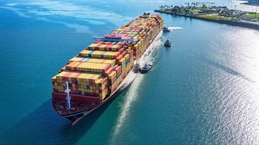
Widespread carrier diversions away from the Red Sea and Suez Canal to avoid the threat of Houthi attacks are impacting ocean operations for ex-Asia trade to N. Europe, the Mediterranean and North America's East Coast, according to a new Freightos analysis.
It said that longer transit times have disrupted schedules and have carriers and port operators rushing to revise arrival slot allocations in an attempt to avoid the "vessel bunching" of multiple ships arriving at once that was one driver of port congestion and delays at Europe's major hubs during the pandemic.
Judah Levine, head of research at Freightos noted that relatively low container yard density at the moment and lessons learned during COVID will work in favor of ports trying to avoid significant backlogs.
"Carriers are adding additional vessels to their rotations and are sailing faster to keep up with departure schedules in Asia, but the longer trips will mean more time required to repatriate empty containers and could lead to shortages at Asian origin ports," he said.
Levine added that if carriers start omitting port calls and offloading containers at alternate destination ports to compensate, these steps could also contribute to delays for shippers and the possibility of congestion at larger hubs.
"At the same time, demand may be increasing as shippers start to pull forward volumes to make up for longer transit times and in preparation for China’s Lunar New Year holiday in early February," he said.
Increased costs up to US$2M per round trip
Nonetheless, though prices have not spiked just yet, carriers facing higher costs — estimated at as much as US$2M per round trip — for longer transits, as well as the possible increase in demand will push ocean rates up significantly in January, the report added.
Even before the diversions, carriers had announced plans for January GRIs to elevate Asia-Europe and Mediterranean rates to above US$3,000/FEU.
The report said the success of those increases would've depended on blanked sailings and other capacity reduction measures, which now will be cancelled as those extra ships will instead be activated to service the now significantly longer loops.
Levine explained that on top of the spot rate increases, carriers have announced a deluge of Asia - Europe surcharges — ranging from $500 to more than US$2,000 per container depending on the carrier and the specific lane — starting on January 1 to pass costs on to their customers.
"Taken together, these GRIs and surcharges, if successful, could push spot rates up to the US$4K - US$5/FEU level while diversions continue," he added.
Asia-N. America operations and rates will likely be impacted as well.
Levine said some Asia - US East Coast services, especially from the Indian Subcontinent, typically sail via the Suez Canal and will now divert around the south of Africa.
Some carriers have already announced US$1,500/FEU GRIs and significant surcharges for India - N. America containers, and US$500/FEU surcharges for all transpacific shipments starting in mid-January, though surcharge announcements for N. America have not been widespread so far.
He added that the number of impacted Asia-N. American vessels will be even higher than usual as several carriers have already rerouted some services – that normally transit the Panama Canal on their way to the East Coast – to the Suez to avoid possible Panama Canal drought-driven delays and extra costs.
"The US West Coast may also be impacted in the form of an increase in volumes as some shippers are already shifting away from the East Coast to avoid the increase in transit times for time-sensitive shipments," Levine said.
"This upward pressure on rates – which will be welcomed by carriers facing overcapacity and now starting Asia - N. America long-term contract negotiations – is likely to persist until carriers feel comfortable returning to the Red Sea," he added.
The Freightos report said even with the US-led naval coalition in place, attacks have continued.
The US has indicated that the naval force will use a defensive strategy to secure the waterway, while the Houthis have threatened to attack US Navy ships if Houthi positions are targeted.
But, with the task force in place, Maersk and CMA CGM have already started scheduling some vessels to return to the Red Sea in the coming days and have announced that they will resume normal operations as soon as possible, though they have not given a definite timeline for a full return.
Other carriers like Hapag-Lloyd and MSC, meanwhile, have no plans to return even with the new security measures.
"In air cargo, some analysts are expecting the delays in ocean freight to lead to some shift of more urgent volumes to sea-air services or air cargo alternatives," the head of research at Freightos said.
"So far, there have not been reports of any significant air cargo bump, though," Levine added, noting that Freightos Air Index rates for Asia - N. America were level last week, while Asia - N. Europe prices decreased.



